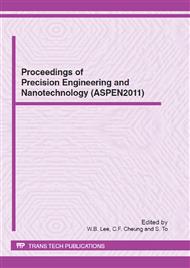[1]
T.G. Bifano, Ductile Regime Grinding Of Brittle Materials, PhD Thesis, North Carolina State University, (1988).
Google Scholar
[2]
D. Grimme, K. Rickens, Q. Zhao, C. Heinzel, Dressing of coarse-grained diamond wheels for ductile machining of brittle materials, Towards Synthesis of Micro-/Nanosystems B7 (2007) 305-307.
DOI: 10.1007/1-84628-559-3_53
Google Scholar
[3]
K. Liu, X.P. Li, Ductile cutting of tungsten carbide, J. Mater. Process. Technol. 113 (2001) 348-354.
Google Scholar
[4]
K. Liu, X.P. Li, M. Rahman, X.D. Liu, CBN tool wear in ductile cutting of tungsten carbide, Wear 255 (2003) 1344-1351.
DOI: 10.1016/s0043-1648(03)00061-9
Google Scholar
[5]
H. Suzuki et al., Study on precision grinding of micro aspherical surface: effects of tool errors on workpiece form accuracies and its compensation methods, J. Jpn Soc. Prec. Eng. 65 (1999) l401-405.
Google Scholar
[6]
W.K. Chen, T. Kuriyagawa, H. Huang, H. Ono, M. Saeki, K. Syoji, A novel form error compensation technique for tungsten carbide mould insert machining utilizing parallel grinding technology, Key Eng. Mat. 257–258 (2004) 141-146.
DOI: 10.4028/www.scientific.net/kem.257-258.141
Google Scholar
[7]
Y. Yamamoto, H. Suzuki, T. Onishi, T. Okino, T. Moriwaki, Precision grinding of microarray lens molding die with 4-axes controlled microwheel, Sci. Tech. Adv. Mat. 8 (2007) 173-176.
DOI: 10.1016/j.stam.2007.02.007
Google Scholar
[8]
H. Suzuki, T. Moriwaki, Y. Yamamoto, Y. Goto Precision Cutting of Aspherical Ceramic Molds with Micro PCD Milling Tool, CIRP Ann – Manuf. Tech. 56 (2007) 131-134.
DOI: 10.1016/j.cirp.2007.05.033
Google Scholar
[9]
W. Boehlke: Hartmetall - ein moderner Hochleistungswerkstoff, Materialwissenschaften und Werkstofftechnik , no. 33, p.575 – 580, (2002).
DOI: 10.1002/1521-4052(200210)33:10<575::aid-mawe575>3.0.co;2-1
Google Scholar
[10]
H. Salmang; H. Scholze, R. Telle: Keramik, Springer-Verlag Berlin Heidelberg, (2007).
Google Scholar
[11]
F. Klocke; W. König: Fertigungsverfahren 2 – Schleifen, Hohnen, Läppen, 4., neu überarbeitete Auflage, Springer-Verlag Berlin Heidelberg, (2005).
Google Scholar


